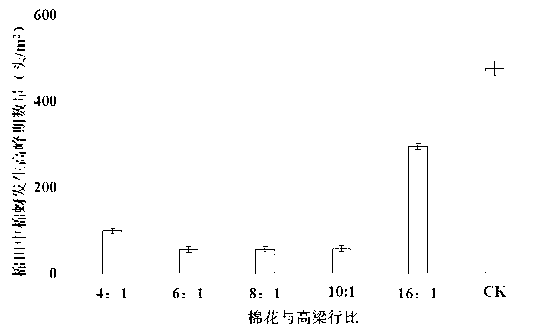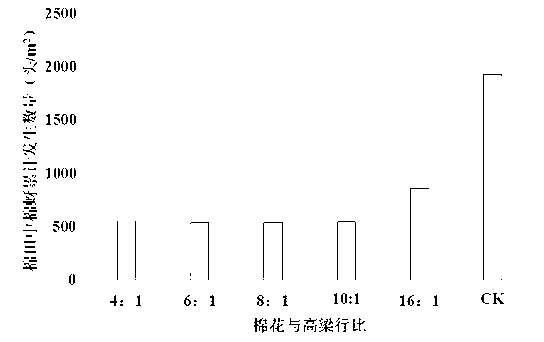Cotton aphid control method
A cotton aphid and cotton technology, which is applied in the agricultural field, can solve the problems of increasing the harm of the lily bug, and achieve the effects of strong field adaptability and simple planting.
- Summary
- Abstract
- Description
- Claims
- Application Information
AI Technical Summary
Problems solved by technology
Method used
Image
Examples
Embodiment 1
[0017] A method for preventing and controlling cotton aphids, which is realized by proliferating natural natural enemies in the field with sorghum aphids bred on sorghum, by planting sorghum belts on the edge of cotton belts, the number of rows of the cotton is 8 rows, and the row number of the sorghum The number is 1 row, and the row spacing of the cotton is 30cm.
[0018] The sorghum is sweet sorghum.
Embodiment 2
[0020] A method for preventing and controlling cotton aphids, realized by multiplying natural natural enemies in the field by sorghum aphids bred on sorghum, by planting sorghum belts on the edge of cotton belts, the number of rows of the cotton is 16 rows, and the number of rows of the sorghum Number is 2 rows, and the row spacing of described cotton is 40cm, and the row spacing of described sorghum is 45cm.
[0021] The sorghum is glutinous sorghum.
Embodiment 3
[0023] A method for preventing and controlling cotton aphids, realized by multiplying natural natural enemies in the field by sorghum aphids bred on sorghum, and realizing by planting sorghum belts on the edge of cotton belts, the number of rows of the cotton is 32 rows, and the row number of the sorghum Number is 4 rows, and the row spacing of described cotton is 50cm, and the row spacing of described sorghum is 50cm.
[0024] The sorghum is glutinous sorghum and sweet sorghum.
[0025]
PUM
| Property | Measurement | Unit |
|---|---|---|
| Line spacing | aaaaa | aaaaa |
| Line spacing | aaaaa | aaaaa |
Abstract
Description
Claims
Application Information
 Login to View More
Login to View More - R&D
- Intellectual Property
- Life Sciences
- Materials
- Tech Scout
- Unparalleled Data Quality
- Higher Quality Content
- 60% Fewer Hallucinations
Browse by: Latest US Patents, China's latest patents, Technical Efficacy Thesaurus, Application Domain, Technology Topic, Popular Technical Reports.
© 2025 PatSnap. All rights reserved.Legal|Privacy policy|Modern Slavery Act Transparency Statement|Sitemap|About US| Contact US: help@patsnap.com



